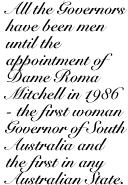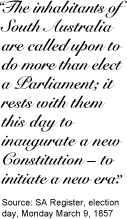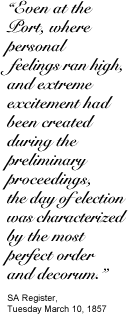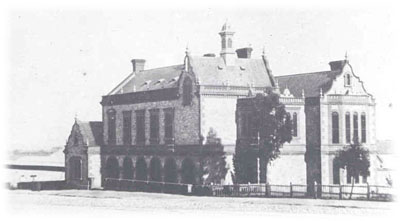South Australia's Parliamentary Constitution
An advanced democratic constitution
The Constitution which gave South Australia self-government and its first Parliament was passed in 1856, and the first Parliament met in April of 1857.
South Australia now had a Constitution which was one of the most advanced in the world. This was a time when many countries had no representative institutions, or where only the wealthier or landowning groups had the right to vote. There was great pride in this achievement.
The voting system
Parliament had two chambers - the House of Assembly and the Legislative Council. Members had to be elected. Who could vote?
For the House of Assembly - All adult males over the age of 21- Universal Manhood Suffrage.
For the Legislative Council - Males owning property worth £50 or leasing property worth £20, or occupying property worth £25 a year. Although the vote was restricted to men of property, it was set at a much lower level than for the Upper Houses of the other Australian Parliaments. So voting for the South Australian Legislative Council was open to a larger proportion of the population.
The franchise clause in the Constitution had been worded very carefully. John Baker asked for it to be clarified, "otherwise it would give the vote not only to aborigines but also to females". In fact the wording of the Act included Aboriginal men in the vote, but no women were allowed to vote at all.
For the Legislative Council, the whole State was one voting district. This meant that men of property who qualified were entitled to just one vote - unlike other property qualification systems where they had a vote in each of the districts where they owned or rented property.
Voting was to be done by secret ballot. The secret ballot had been talked about and supported in South Australia for many years - since the early days of planning for the colony. But it was a very progressive idea for its time. South Australia, along with Victoria, were the first places in the world to use the secret ballot, and for many years this system was known in the United States as "the Australian ballot".
Voting was voluntary and the winner was the candidate with the greatest number of votes - the "first past the post" system. Preferential and compulsory voting were introduced much later.
The different powers of the two chambers of Parliament were based on the model of the British Parliament, so the House of Assembly was regarded as the more democratic chamber. Money bills had to be introduced into Parliament in that House.
Later Changes
The Constitution of 1857 is still largely the constitution that South Australia operates under today, but there have also been some important changes between 1857 and now.
Votes for women.
Reforming the franchise for the Legislative Council.
Equal electoral districts.
Changes to voting - introducing compulsory, preferential and contingent voting, and reducing the voting age.









